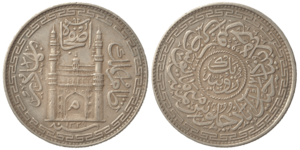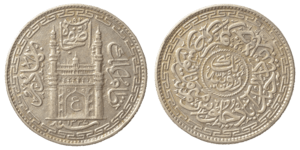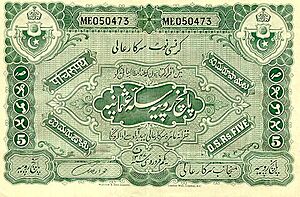Hyderabadi rupee facts for kids
Quick facts for kids Hyderabadi rupee |
|||
|---|---|---|---|
|
|||
| User(s) | |||
| Subunit | |||
| 1⁄16 | anna | ||
| 1⁄192 | pai | ||
| Coins | 1,2 pai, 1⁄2, 1, 2, 4, 8 annas, 1 rupee | ||
| Banknotes | 1, 5, 10, 100, 1000 rupees | ||
The Hyderabadi Rupee was the money used in the Hyderabad State from 1918 to 1959. For a few years after 1950, it was used alongside the Indian rupee. Just like the Indian rupee, it was split into 16 annas. Each anna was then divided into 12 pai. Coins were made from copper or bronze for small amounts like 1 and 2 pai, and half an anna. Larger coins like 1 anna were made of cupro-nickel or bronze, while 2, 4, 8 annas, and 1 rupee coins were made of silver.
Hyderabad was a special princely state in India. It was the only one allowed to keep printing its own money even after it joined the Dominion of India in 1948 and later the Republic of India in 1950.
Contents
History of the Hyderabadi Rupee

For a long time, the government of Hyderabad wanted to create its own paper money. However, the British government did not usually allow Indian princely states to print their own currency.
Why Hyderabad Got Its Own Money
During the First World War, there was a big shortage of silver. Hyderabad also helped the British a lot during the war. Because of these reasons, the British agreed in 1918 to let Hyderabad print paper money. The first notes were for 10 and 100 rupees.
This new money was called the Osmania Sicca (OS). Notes for 1 and 5 rupees were printed in 1919, and 1000 rupee notes came out in 1926. Later, these notes were printed at the India Currency Notes Press in Nashik.
Managing the Currency
In 1942, the government of Hyderabad created the Hyderabad State Bank. One of its main jobs was to manage the Osmania Sicca currency. Hyderabad kept making its own coins until 1948. That year, India took control of the state after its ruler, the Nizam, refused to join the new country.
The End of the Hyderabadi Rupee
In 1950, the Indian rupee was introduced in Hyderabad alongside the local money. The exchange rate was set so that 7 Hyderabadi rupees were worth 6 Indian rupees. In 1951, no more Hyderabadi rupees were printed. The Indian rupee became the main money used. However, the Hyderabadi rupee was still accepted as money until 1959.
Banknotes of Hyderabad


The banknotes of Hyderabad were printed from 1918 until 1953. The ruler at that time was Mir Osman Ali Khan, the Nizam of Hyderabad. Some reports say notes were even issued as early as 1916.
Understanding the Dates and Languages
The dates on the notes are from the Fasli calendar. To find the year in the AD calendar, you just add 589 to the Fasli date. The value of the money was written in several languages: Urdu, Marathi, Telugu, Kannada, and English.
The Sunken Ship Notes
In 1932, a special discovery was made. Some Hyderabadi notes (for 5, 10, and 100 rupees) were found in the SS Egypt, a ship that sank in 1922 off the coast of France. These notes had never been used but were stained by the sea. They were being shipped from England, where they had been printed. Many of these notes were given a special stamp and sold as souvenirs. They are very interesting to people who collect old money, called notaphilists.
Signature Chart
The person who signed a banknote can help tell when it was issued. The names below are of the officials who signed the notes. Their titles were usually in Urdu.
- Sir Reginald R. Clancy (1918–19)
- Fakhr-ud-Din Ahmad (1919–20)
- Hyder Nawaz Jung (1921–36)
- Fakhr-Yar Jung (1936–38 and 1940–41)
- Mehdi Yar Jung (1939)
- Sir Ghulam Muhammad (1941–45)
- Liaquat Jung (1945 and 1946–47)
- Zahed Husain (1945–46)
- Zahed Jung (1946)
- Moin Nawaz Jung (1947–48)
- D.R. Pradhan (1948–49)
- C.V.S. Rao (1950)
- Dr. G.S. Melkote (1950–53)
Important Banknote Issues
- First Issue (1918-19): These notes included 1 rupee and 10 rupees.
- Second Issue (1919-20): This issue included 5, 10, and 100 rupee notes. Many of these were the "sea salvage" notes found from the sunken ship.
- Third Issue (1921-36): This was a long period of issues, including 5, 10, 100, and 1,000 rupee notes.
- Fourth Issue (1936-38): Notes for 5, 10, and 100 rupees were printed.
- Fifth Issue (1939): This issue included 1, 5, 10, and 100 rupee notes.
- Sixth Issue (1940-41): Only 1 rupee notes were part of this issue.
- Seventh Issue (1941-45): Notes for 1, 5, 10, and 100 rupees were printed during this time.
- Eighth Issue (1945): This included 1 rupee and 100 rupee notes.
- Ninth Issue (1945-46): Notes for 1, 5, 10, and 100 rupees were part of this series.
- Tenth Issue (1946): This issue included 1 rupee notes.
- Eleventh Issue (1946-47): Notes for 1, 5, and 10 rupees were printed.
- Twelfth Issue (1947-48): This issue is special because it came out when Hyderabad tried to become an independent country. It included 1 rupee notes.
- Thirteenth Issue (1948-49): This was the first issue after Hyderabad joined India. It included 1 rupee notes.
- Fourteenth Issue (1950): This issue came out after India became a republic. It included 1 rupee notes.
- Fifteenth Issue (1950-53): This was the final issue of Hyderabadi Rupee notes, including 1 rupee notes.




